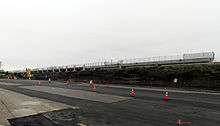Newmarket (MBTA station)
NEWMARKET | |||||||||||||||
|---|---|---|---|---|---|---|---|---|---|---|---|---|---|---|---|
|
The newly-opened station in July 2013 | |||||||||||||||
| Location |
Massachusetts Avenue and Newmarket Square Dorchester, Massachusetts | ||||||||||||||
| Coordinates | 42°19′38″N 71°03′57″W / 42.3271°N 71.0659°WCoordinates: 42°19′38″N 71°03′57″W / 42.3271°N 71.0659°W | ||||||||||||||
| Owned by | MBTA | ||||||||||||||
| Line(s) | |||||||||||||||
| Platforms | 2 side platforms | ||||||||||||||
| Tracks | 2 | ||||||||||||||
| Connections |
| ||||||||||||||
| Construction | |||||||||||||||
| Bicycle facilities | 20 spaces | ||||||||||||||
| Disabled access | Yes | ||||||||||||||
| Other information | |||||||||||||||
| Fare zone | 1A | ||||||||||||||
| History | |||||||||||||||
| Opened | July 1, 2013[1][2] | ||||||||||||||
| Services | |||||||||||||||
| |||||||||||||||
Newmarket is a passenger rail station on the MBTA Commuter Rail's Fairmount Line, located off Massachusetts Avenue at Newmarket Square in Dorchester, Massachusetts. The station has two 800-foot high-level platforms and sloping walkways connecting it to Massachusetts Avenue.[3] Originally planned to be in service in 2011, it opened on July 1, 2013 along with Four Corners/Geneva Ave.[1]
History

Previous service
Service on the Fairmount Line (as the Dorchester Branch of the Norfolk County Railroad and later the New York and New England Railroad and New York, New Haven and Hartford Railroad) began in 1855 and lasted until 1944. There were stations located in South Boston and at Dudley Street (now the site of Uphams Corner station) but not at Massachusetts Avenue.[4] Newmarket is thus the first railroad station located at the site. Temporary shuttle service resumed on the Fairmount Line in 1979 during Southwest Corridor construction, with stops at Uphams Corner, Morton Street, and Fairmount. The MBTA planned to drop the shuttle after service resumed on the Southwest Corridor in 1987, but the service was locally popular and the Fairmount Line became a permanent part of the system.
Improvement project
A plan called the Indigo Line was later advanced by community activists in which the line would add stations and more frequent service to closely resemble a conventional rapid transit line. The Indigo Line plan was not adopted, but elements of it were included when the Commonwealth of Massachusetts agreed in 2005 to make improvements on the Fairmount Line part of its legally binding commitment to mitigate increased air pollution from the Big Dig. Among the selected improvements in the Fairmount Line Improvements project were four new commuter rail stations on the line, including one at Massachusetts Avenue. The stations were originally to be completed by the end of 2011.[5]
Construction
After several years of planning, bidding for the $12.283 million station contract opened on August 18, 2010.[6][7] The $12 million contract was awarded to S&R Construction of New Hampshire and work began in January 2011.[3][8] The station was then scheduled for completion in 2012, but was delayed due to the discovery of an electrical power bank — missing from NStar plans — connected to the adjacent shopping center.[5]
By April 2012, the station was 49% complete; the platforms were in place but no ramps or canopies had been constructed.[5] By September, canopies were in place and the ramps were under construction. After substantial work during the summer, the station was 70% complete by mid-September.[9] Completion reached 85% by April 2013. Newmarket was substantially completed for its opening on July 1, 2013, with all construction to be finished by August 2013.[10][2] Ribbon-cutting ceremonies were held at Newmarket, Four Corners/Geneva Ave, and Talbot Ave on July 17, 2013.[11]
During service disruptions at South Station, Newmarket is used as the inbound terminus of the Fairmount Line, with bus connections to nearby Andrew station or directly to South Station.[12]
Bus connections
The station is served by four MBTA Bus routes:
- 8 - Harbor Point/UMass - Kenmore Station via B.U. Medical Center & Dudley Station
- 10 - City Point - Copley Square via Andrew Station & B.U. Medical Center
- 16 - Forest Hills Station - Andrew Station or UMass via Columbia Road
- CT3 - Beth Israel Deaconess Medical Center - Andrew Station via B.U. Medical Center
References
- 1 2 Rocheleau, Matt (25 June 2013). "Commuter rail gives Fairmount a boost". Boston Globe. Retrieved 5 July 2013.
- 1 2 Belcher, Jonathan (27 December 2014). "Changes to Transit Service in the MBTA district" (PDF). NETransit. Retrieved 6 July 2015.
- 1 2 "Newmarket Station". Massachusetts Bay Transportation Authority. Retrieved 4 May 2012.
- ↑ Leo S. (26 December 2009). "Railroad Stations in Dorchester". Dorchester Atheneum. Retrieved 18 June 2012.
- 1 2 3 "State Implementation Plan – Transit Commitments Monthly Status Report" (PDF). Massachusetts Department of Transportation. 19 April 2012. Retrieved 18 June 2012.
- ↑ "Notice to Bidders" (PDF). Massachusetts Bay Transportation Authority. 16 August 2010. Retrieved 19 June 2012.
- ↑ "MBTA Fairmount Line Newmarket Station Moves Forward". Massachusetts Department of Transportation. 17 August 2010. Retrieved 3 August 2011.
- ↑ "Shea Concrete to provide precast concrete products for Newmarket Station". World Construction Network. 2 May 2011. Retrieved 3 August 2011.
- ↑ "State Implementation Plan – Transit Commitments Monthly Status Report" (PDF). Massachusetts Department of Transportation. 20 September 2012. Retrieved 4 October 2012.
- ↑ "State Implementation Plan – Transit Commitments Monthly Status Report" (PDF). Massachusetts Department of Transportation. 18 April 2013. Retrieved 17 May 2013.
- ↑ "Patrick Administration Opens Three New Commuter Rail Stations". Massachusetts Bay Transportation Authority. 17 July 2013. Retrieved 17 July 2013.
- ↑ Ortiz, Aimee; Dungca, Nicole (19 February 2016). "Amtrak signal fixed, normal service resumes to South Station". Boston Globe. Retrieved 19 February 2016.
Only the Providence/Stoughton lines left from South Station, while the others were rerouted to Back Bay, Newmarket, Quincy Center, Braintree, and JFK/UMass.
External links
| Wikimedia Commons has media related to Newmarket (MBTA station). |